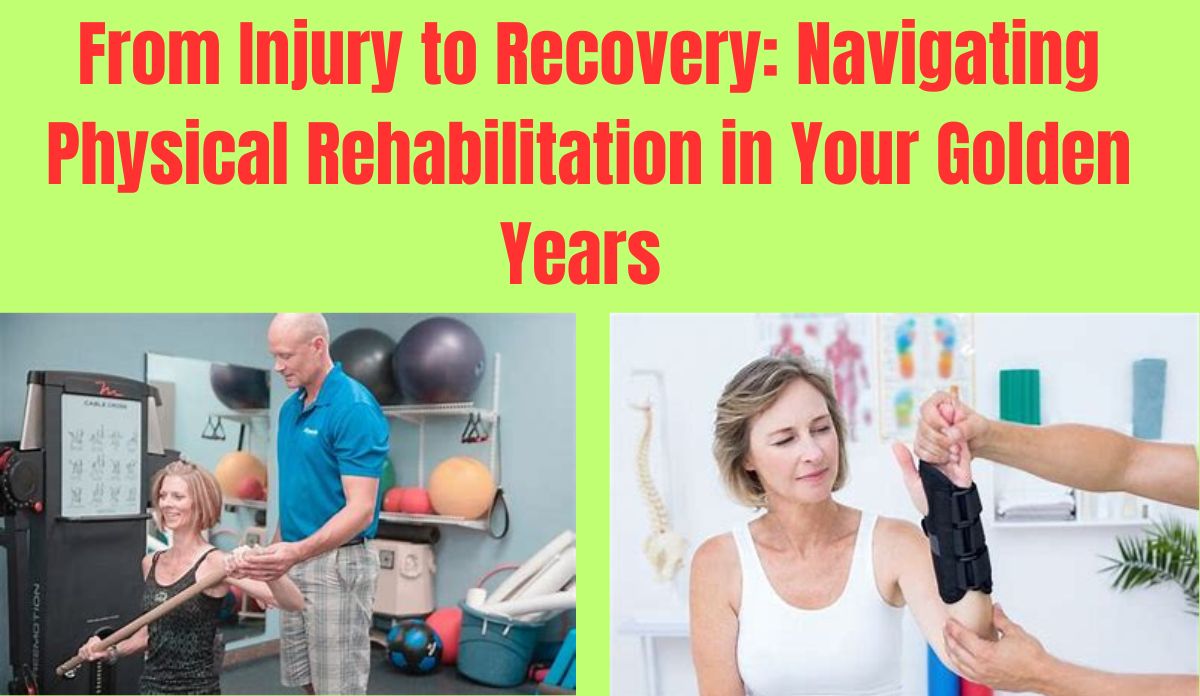As we age, our bodies undergo various changes that can increase the risk of injuries and decrease our ability to recover from them. However, growing older doesn’t mean you have to resign yourself to a sedentary lifestyle and accept pain and limitations as a part of aging. With the right approach to physical rehabilitation, seniors can regain their mobility, independence, and quality of life after an injury. This article explores the challenges and solutions for navigating physical rehabilitation in your golden years, helping you embrace the aging process with confidence and resilience.
I. Understanding the Challenges of Aging and Injury

Aging brings several physiological changes that make seniors more susceptible to injuries and slower recovery times.
Some of the challenges seniors face include:
- Decreased Bone Density: Aging often leads to reduced bone density, making bones more fragile and prone to fractures.
- Muscle Loss: Seniors tend to experience muscle loss, known as sarcopenia, which weakens the musculoskeletal system and affects balance and strength.
- Reduced Joint Flexibility: Joints become less flexible with age, increasing the risk of falls and injuries.
- Slower Healing Process: As we age, our bodies take longer to heal, making it crucial to address injuries promptly and effectively.
- Chronic Conditions: Many seniors have pre-existing chronic conditions, such as arthritis or diabetes, that can complicate the recovery process.
From Injury to Recovery
II. Navigating Physical Rehabilitation
Seek Professional Guidance: When dealing with an injury, it is essential to seek the guidance of healthcare professionals specializing in geriatric care and physical rehabilitation. Physical therapists, occupational therapists, and geriatric physicians can tailor a recovery plan to your specific needs and goals.
- Embrace Rest and Recovery: While it may be tempting to rush back to your normal routine after an injury, allowing sufficient time for rest and recovery is crucial. Adequate rest helps the body heal and reduces the risk of re-injury.
- Focus on Nutrition: A balanced diet rich in nutrients helps support the healing process and maintains overall health. Adequate protein intake is particularly essential for preserving and rebuilding muscle mass.
- Stay Active within Limits: Engaging in appropriate physical activities can aid in recovery and prevent further injuries. However, it’s crucial to stay within your limitations and avoid activities that could exacerbate the injury.
- Address Mental Health: Physical rehabilitation can be a challenging and sometimes frustrating process. Addressing mental health and seeking emotional support can positively impact the recovery journey.
- Fall Prevention: To reduce the risk of falls and subsequent injuries, make your living space safe by removing tripping hazards, installing grab bars, and using assistive devices if necessary.
- Utilize Assistive Devices: Mobility aids like canes, walkers, or orthotics can enhance stability and support during the recovery process.
- Maintain Social Connections: Staying connected with friends, family, and support groups can boost morale and provide a sense of belonging during rehabilitation.
III. Tailoring Rehabilitation Programs
Effective rehabilitation programs for seniors should be tailored to address their specific needs and challenges.
Some essential components of such programs include:
- Flexibility and Range of Motion Exercises: Gentle stretching exercises help maintain joint flexibility and range of motion, reducing the risk of stiffness and immobility.
- Strengthening Exercises: Age-appropriate strength training exercises help build muscle mass, increase bone density, and improve overall body strength.
- Balance and Stability Training: Balance exercises are crucial for preventing falls and improving stability.
- Cardiovascular Conditioning: Low-impact cardiovascular exercises like walking or swimming can improve heart health and stamina without putting excessive stress on joints.
- Pain Management: Addressing pain through various modalities, such as heat therapy, ice packs, or non-invasive pain-relieving techniques, can improve comfort during rehabilitation.

- Functional Training: Rehabilitation should focus on real-life activities to regain independence in daily tasks.
IV. Technology in Rehabilitation
Advancements in technology have significantly impacted the field of physical rehabilitation, providing innovative solutions for seniors:
- Virtual Rehabilitation: Tele-rehabilitation allows seniors to access physical therapy sessions from the comfort of their homes, reducing the need for frequent travel and enhancing convenience.
- Wearable Devices: Fitness trackers and wearable technology can monitor vital signs, track progress, and provide feedback, motivating seniors to stay active and engaged in their rehabilitation.
- Exoskeletons: Powered exoskeletons can assist seniors in walking or performing daily activities, aiding in the rehabilitation process.
- Virtual Reality (VR) Therapy: VR therapy is used to create immersive environments that stimulate movement and cognitive functions, making rehabilitation engaging and enjoyable.
Conclusion
As we age, physical rehabilitation becomes an essential aspect of maintaining a healthy and active lifestyle. Navigating rehabilitation in your golden years may present challenges, but with the right approach, dedication, and support, seniors can regain their mobility, independence, and overall well-being after an injury. Seeking professional guidance, staying active within limits, focusing on nutrition, and utilizing technology can make the rehabilitation journey more effective and rewarding. By embracing physical rehabilitation, seniors can navigate the aging process with grace, resilience, and an unwavering determination to live life to the fullest.
You May Also Like:
What Types of Conditions or Injuries Can Benefit from Rehabilitation?
Senior Citizens: Facing the Challenges of Aging
The 60-Day Challenge: Nova Care Rehabilitation’s Road to Wellness
Transform Your Life in 90 Days with Nova Care Rehabilitation
Top 7 Mental Health Benefits for Senior Citizens
FAQ Page
What is “From Injury to Recovery: Navigating Physical Rehabilitation in Your Golden Years”?
This is a guide that provides valuable information and insights to senior individuals who have experienced injuries and are seeking guidance on the process of physical rehabilitation. It offers tips, advice, and resources to navigate the recovery journey successfully.
Why is physical rehabilitation essential for seniors?
Physical rehabilitation is crucial for seniors as it helps them recover from injuries, regain mobility, reduce pain, and enhance their overall quality of life. It also promotes independence and prevents further health complications.
What types of injuries are covered in the guide?
The guide covers a wide range of injuries commonly experienced by seniors, including fractures, joint replacements, sprains, strains, and other musculoskeletal issues.
Who can benefit from this guide?
This guide is specifically designed for seniors who have experienced injuries and are undergoing or considering physical rehabilitation as part of their recovery process.
What can I expect during the physical rehabilitation process?
The guide provides an overview of the typical physical rehabilitation journey, including the assessment phase, personalized treatment plans, therapy exercises, and the progression of exercises over time.
Is it safe for seniors to engage in physical rehabilitation?
Yes, physical rehabilitation is generally safe for seniors. However, working with qualified healthcare professionals who can design appropriate rehabilitation plans and closely monitor progress to prevent complications is essential.
Can I do physical rehabilitation at home, or do I need to visit a specialized facility?
The guide covers both options. Depending on the severity of the injury and the individual’s overall health, some rehabilitation exercises can be done at home with proper guidance. However, for more complex cases, visiting a specialized rehabilitation facility might be necessary.
How long does the physical rehabilitation process typically take for seniors?
The duration of the rehabilitation process varies depending on the type of injury, overall health, and progress made during the therapy. It may take weeks or months.
Are there any lifestyle tips provided in the guide to aid in recovery?
Yes, the guide offers lifestyle tips for seniors to support their recovery journey, such as maintaining a balanced diet, staying hydrated, getting enough rest, and engaging in activities that promote overall well-being.
How can I find a qualified physical therapist or rehabilitation facility?
Answer The guide provides tips on how to find reputable and qualified physical therapists or rehabilitation facilities, including researching local resources, reading reviews, and seeking recommendations from healthcare professionals.
Can I download the guide, and is it available for free?
The availability and accessibility of the guide may vary. It might be available as a downloadable resource on particular websites or offered by healthcare institutions or senior-focused organizations. It’s best to check the source from which the guide is being distributed for information about its availability and cost.






Adult products designed in China account for around 70 p.c of the global market,初音 ミク ラブドール As outlined by media studies.
Thanks, Kindly write all comments in my article below comment section.